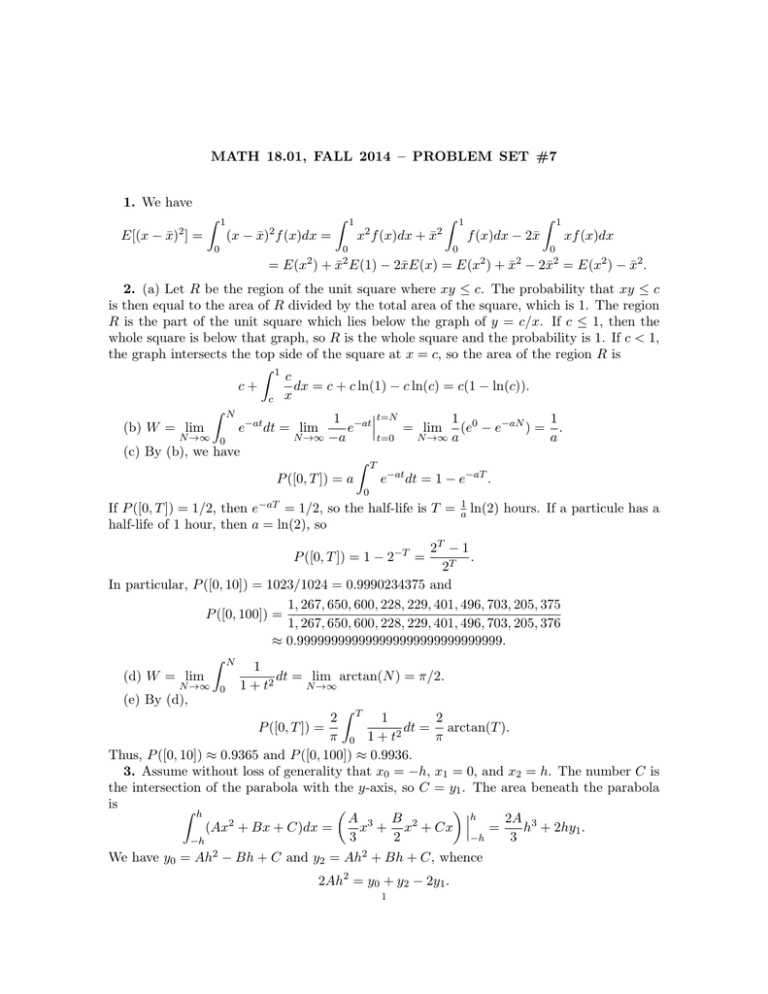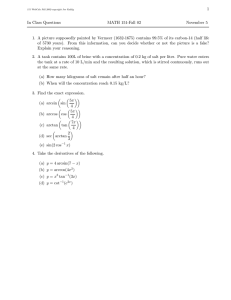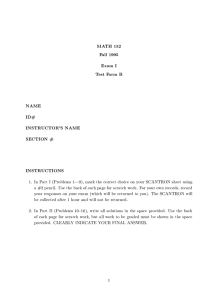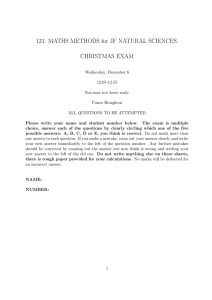MATH 18.01, FALL 2014 – PROBLEM SET #7 1. We have Z
advertisement

MATH 18.01, FALL 2014 – PROBLEM SET #7 1. We have E[(x − x̄)2 ] = Z 1 (x − x̄)2 f (x)dx = Z 1 x2 f (x)dx + x̄2 Z Z 1 f (x)dx − 2x̄ xf (x)dx 0 2 0 0 2 0 1 = E(x2 ) + x̄ E(1) − 2x̄E(x) = E(x2 ) + x̄2 − 2x̄ = E(x2 ) − x̄2 . 2. (a) Let R be the region of the unit square where xy ≤ c. The probability that xy ≤ c is then equal to the area of R divided by the total area of the square, which is 1. The region R is the part of the unit square which lies below the graph of y = c/x. If c ≤ 1, then the whole square is below that graph, so R is the whole square and the probability is 1. If c < 1, the graph intersects the top side of the square at x = c, so the area of the region R is Z 1 c c+ dx = c + c ln(1) − c ln(c) = c(1 − ln(c)). c x Z N 1 −at t=N 1 1 −at (b) W = lim e dt = lim e = lim (e0 − e−aN ) = . N →∞ 0 N →∞ −a N →∞ a a t=0 (c) By (b), we have Z T P ([0, T ]) = a e−at dt = 1 − e−aT . 0 e−aT If P ([0, T ]) = 1/2, then = 1/2, so the half-life is T = half-life of 1 hour, then a = ln(2), so 1 a ln(2) hours. If a particule has a 2T − 1 . 2T In particular, P ([0, 10]) = 1023/1024 = 0.9990234375 and 1, 267, 650, 600, 228, 229, 401, 496, 703, 205, 375 P ([0, 100]) = 1, 267, 650, 600, 228, 229, 401, 496, 703, 205, 376 ≈ 0.999999999999999999999999999999. Z N 1 (d) W = lim dt = lim arctan(N ) = π/2. N →∞ 0 1 + t2 N →∞ (e) By (d), Z 2 T 1 2 P ([0, T ]) = dt = arctan(T ). 2 π 0 1+t π Thus, P ([0, 10]) ≈ 0.9365 and P ([0, 100]) ≈ 0.9936. 3. Assume without loss of generality that x0 = −h, x1 = 0, and x2 = h. The number C is the intersection of the parabola with the y-axis, so C = y1 . The area beneath the parabola is Z h A 3 B 2 2A 3 h 2 (Ax + Bx + C)dx = x + x + Cx = h + 2hy1 . 3 2 3 −h −h P ([0, T ]) = 1 − 2−T = We have y0 = Ah2 − Bh + C and y2 = Ah2 + Bh + C, whence 2Ah2 = y0 + y2 − 2y1 . 1 2 MATH 18.01, FALL 2014 – PROBLEM SET #7 Thus, the area is h h (y0 + y2 − 2y1 ) + 2hy1 = (y0 + y2 + 4y1 ). 3 3 4. x 0 1/8 1/4 3/8 1/2 5/8 3/4 7/8 1 sinc(x) 1 .997398 .989616 .976727 .958851 .936156 .908851 .877193 .841471 Recall that Simpson’s rule with 2n intervals of length h is Z b n hX f (x)dx ≈ (y2i−2 + 4y2i−1 + y2i ). 3 a i=1 R1 Using 4 intervals of length 1/4, we get 0 sinc(x)dx ≈ .946087. R1 Using 8 intervals of length 1/8, we get 0 sinc(x)dx ≈ .946083. The latter matches the actual value. 5. (a) Let u = tan x, du = sec2 x dx. Then Z Z n+2 tan x dx = tann x(sec2 x − 1)dx Z Z Z 1 n n n+1 = u du − tan x dx = tan x − tann x dx. n+1 (b) Applying (a) for n = 2 and for n = 0, we get: Z Z Z 1 1 3 2 3 4 tan x dx = tan x − tan x dx = tan x − tan x + tan0 x dx 3 3 1 = tan3 x − tan x + x. 3 6. It is possible to find the area of the segment by elementary means, by taking the area of the whole sector and subtracting the area of the triangle. This gives: p area(segment) = area(sector) − area(triangle) = a2 arccos(b/a) − b a2 − b2 . We can give a different proof using integration. If we place the x-axis on the chord with the origin at the closest√point from the center of the region √ the circle, the segment becomes √ below the graph of y = a2 − x2 − b between ± a2 − b2 . Let’s abbreviate a2 − b2 to c and let α = arccos(b/a) = arcsin(c/a) be the half-angle of the sector. Using the substituion x = a sin θ, we have p a2 − x2 = a cos θ and dx = a cos θ dθ, whence Z α p 2 2 area(segment) = ( a − x − b)dx = (a2 cos2 θ − ba cos θ)dθ −c −α α 2θ 2 2 sin θ cos θ = a +a − ba sin θ = a2 α + bc − 2bc = a2 α − bc. 2 4 −α Z c Thus we recover the above formula.




